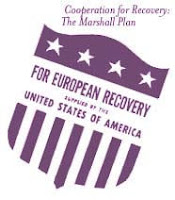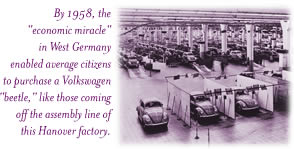The Most Destructive War in History
By the end of World War II, much of Europe and Asia, and parts of Africa, lay in ruins. Combat and bombing had flattened cities and towns, destroyed bridges and railroads, and scorched the countryside. The war had also taken a staggering toll in both military and civilian lives.
Shortages of food, fuel, and all kinds of consumer products persisted and in many cases worsened after peace was declared. War-ravaged Europe and Japan could not produce enough goods for their own people, much less for export.
What was needed to pull Europe and Asia back into the international economy? The answer was money - but what kind? The currencies of war-torn countries? Gold? Dollars?
The Most Expensive War in History
In addition to the toll in human lives and suffering, countries spent more money on World War II than in all previous wars put together. By 1945, exhausted countries faced severe economic problems that frustrated reconstruction efforts:
- Inflation
- Debt (mostly owed to the United States)
- Trade deficits
- Balance of payments deficits
- Depleted gold and dollar supplies
The Dollar Gap
The devastated countries needed gold or U.S. dollars (the only currency considered to be "as good as gold") to pay for imports and make debt payments. However, both dollars and gold were alarmingly scarce in the war-scarred countries.
Many countries retreated from the market. Communist Eastern Europe abandoned it altogether. The world’s multilateral financial and trading system faced a serious threat. Only the United States had emerged from the war with the strength and resources to help. But would it step forward?
Worldwide Gold Shortage
By 1947, the United States had accumulated 70% of the world’s gold reserves. The United Kingdom had gone from being the world's greatest creditor to the world's greatest debtor. Countries had sold off most of their gold and dollar reserves, as well as their foreign investments, to pay for the war. What few reserves remained were now quickly running out. Trade deficits meant there was little hope of replenishing them.
Five cigarettes for an egg? A carton of cigarettes for a piano?
Severe inflation plagued the weakened economies. By 1948, wholesale prices were 200% higher in Austria, 1,820% higher in France, and a massive 10,100% higher in Japan than they had been before the war. In 1948, the French government devalued the franc by 80%, making a 5,000 franc note practically worthless. In some countries like Germany, the monetary system collapsed. People resorted to barter, often using cigarettes as money.
Cooperation Tested

The economic situation looked grim in 1947. Forty-four countries had agreed to international economic cooperation at Bretton Woods, but the IMF and the World Bank were not yet in a position to provide the needed expertise and financial assistance. Would countries return to the unilateral beggar-thy-neighbor policies of high tariffs and competitive devaluations?
Potential Solution
Many hoped that the United States would provide economic aid to help resolve the crisis. In contrast to the other combatants, the United States ended the war as the world's greatest creditor, with most of the world's gold, a substantial balance of payments surplus, and virtually no physical damage to its own land. Would the United States offer additional dollar aid? Could the European countries cooperate with one another and the United States to solve their persistent problems and return to prosperity?
Limited Options for Economic Recovery
Desperate countries could gain the dollars they needed only through:
- Exporting more than they imported (balance of trade surplus)
- Private investments or loans from the United States
- U.S. government aid or loans
However, the devastation caused by the war eliminated any hope of a trade surplus. Chaos and uncertainty in the European economies discouraged private US investments. It seemed that only additional government aid or loans could work.
Cooperation
Trade Links Encourage Expansion:
- The United States gives dollars to Country A.
- Country A uses dollars to increase domestic production and pay for imports.
- Country A's economy expands by selling more domestic products to, and buying more imports from, other countries.
- Other economies (including the U.S. economy) expand by selling more domestic products to, and buying more imports from, Country A.
Noncooperation
Without Trade Links, Economies Miss Out on Expansion:
- The United States does not provide dollars to Country A.
- Country A is unable to increase domestic production and unable to afford imports.
- Country A's economy fails to expand, with few products to export and little foreign exchange to buy imports.
- Other economies (including the US economy) fail to expand, unable to sell domestic products to, or buy imports from, Country A.
US Decision
The Case Against
Over $9 billion had been spent already on aid to Europe in the immediate postwar period:
- The United States could not afford to give away more money to other countries. There were pressing needs at home.
- Existing shortages in the United States would be exacerbated and wholesale prices would rise, causing inflation.
- If the United States did nothing, Europe would solve its own economic problems.
The Case For
The United States must act for security, humanitarian, and economic reasons:
- If the United States did not help, Soviet-supported Communists could make inroads into vulnerable Western European countries.
- Innocent people in Europe were suffering from shortages of basic necessities.
- The United States could lose its main export markets if Europe could not find dollars or gold to purchase US products.
"And yet the whole world of the future hangs on a proper judgment...What are sufferings?What is needed?What must be done?"
George C. Marshall,
US Secretary of State
Harvard University,
June 5, 1947
Cooperation for Recovery: The Marshall Plan
Dollar Catalyst
In his historic speech at Harvard's graduation ceremony in June 1947, George Marshall announced the U.S. plan to give additional economic aid to Europe. The offer was made to all of Europe, including the U.S. wartime enemies and the Communist countries of Eastern Europe. However, the recipients would be required to work together to formulate a unified recovery plan.
The European Response
"When the Marshall Plan proposals were announced, I grabbed them with both hands. I felt that it was the first chance we had ever been given since the end of the war to look at [the] European economy as a whole."
Ernest BevinSixteen European countries responded by cooperating on a general reconstruction plan that was accepted by the United States. In the end, a total of $13.6 billion (equivalent to $88 billion in 1997 money) was appropriated to the plan. The Marshall Plan was a success. By 1950, the participating countries had returned to, or exceeded, their prewar production levels.
British Foreign Secretary
The European Recovery Program (ERP - The Marshall Plan) helped Europe to:
- Finance its imports and debts without the burden of future repayment
- Replace, rebuild and expand both private industry and public infrastructure
- Eliminate bottlenecks in production
- Restore consumption to a politically acceptable level
- Establish and fund the European Payments Union to promote multilateral, rather than bilateral, trade
- Eliminate the worldwide dollar shortage
Conditionality
Marshall aid came with "conditionality" - countries wishing to participate had to agree to:
- Develop multilateral payment and trade within Europe
- Move toward currency convertibility
- Move toward eliminating discrimination against U.S. imports
- Encourage reductions in public spending
- Relax government controls such as rationing
- Increase exports to the United States
U.S. Dollars: Fueling the Economy
Even after Marshall Plan aid ended, the United States continued to provide economic assistance to other countries. In addition, as the "Cold War" heated up, US military expenditures abroad rose, particularly during the country's involvement in the Korean War (1950-53). And even more important, US investment abroad grew substantially after World War II.
The outflow of US dollars provided liquidity, which fueled the growing world economy.
IMF Loans
Egypt's 1956 takeover of the Suez Canal provoked an unsuccessful and costly joint U.K.-French military operation. The United Kingdom and France suffered severe financial consequences as a result. They turned to the IMF, which provided them with its largest financial assistance to date.
- $262 million to France
- $1.2 billion to the United Kingdom
US Government Foreign Aid and Spending
Just as the Marshall Plan aid was ending, US military and nonmilitary aid picked up. The continuous outflow of US dollars helped reduce Europe's balance of payments deficit and the worldwide dollar shortage.
Economic Miracles in the 1950s
Europe had recovered its prewar productive capacity by 1950; Japan, by 1952. Their economies grew rapidly over the following decade. As a result, international financial accounts gradually moved toward balance. The dollar shortage had been eliminated.
The System Works
In 1958, the monetary system agreed upon at Bretton Woods was validated when eleven European countries declared their currencies externally convertible. Others were to follow in the next few years.
The dollar-gold exchange standard, based on fixed exchange rates and overseen by the IMF, could finally be realized.
Problems on the Horizon
After 1950, the United States began to register balance of payments deficits. At first, the deficits were welcomed, because the United States enjoyed:
- A strong trade balance
- Ample gold reserves
- A small outflow of private capital
The U.S. government believed that the deficits demonstrated US leadership in providing expanding markets and finance. The US balance of payments deficits provided $7 billion of an $8.5 billion increase in world liquidity during the 1950s. The increase in liquidity enabled the international economy to grow at a record rate.
How long could the United States afford huge deficits without harming its own economy?
And if the United States reduced its deficits, who would provide additional liquidity to allow the world economy to continue growing?
By International Monetary Fund
Source: International Monetary Fund
vein gold







No comments:
Post a Comment
I thank for the comment!